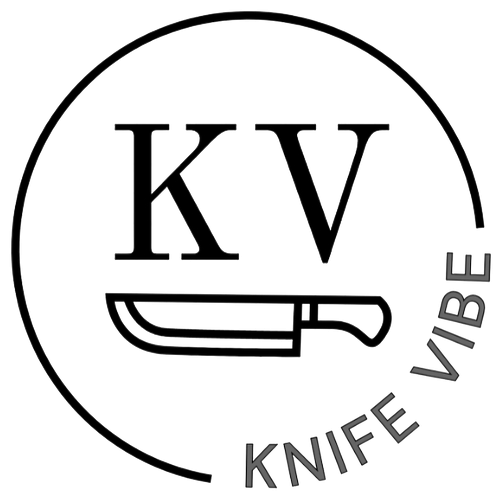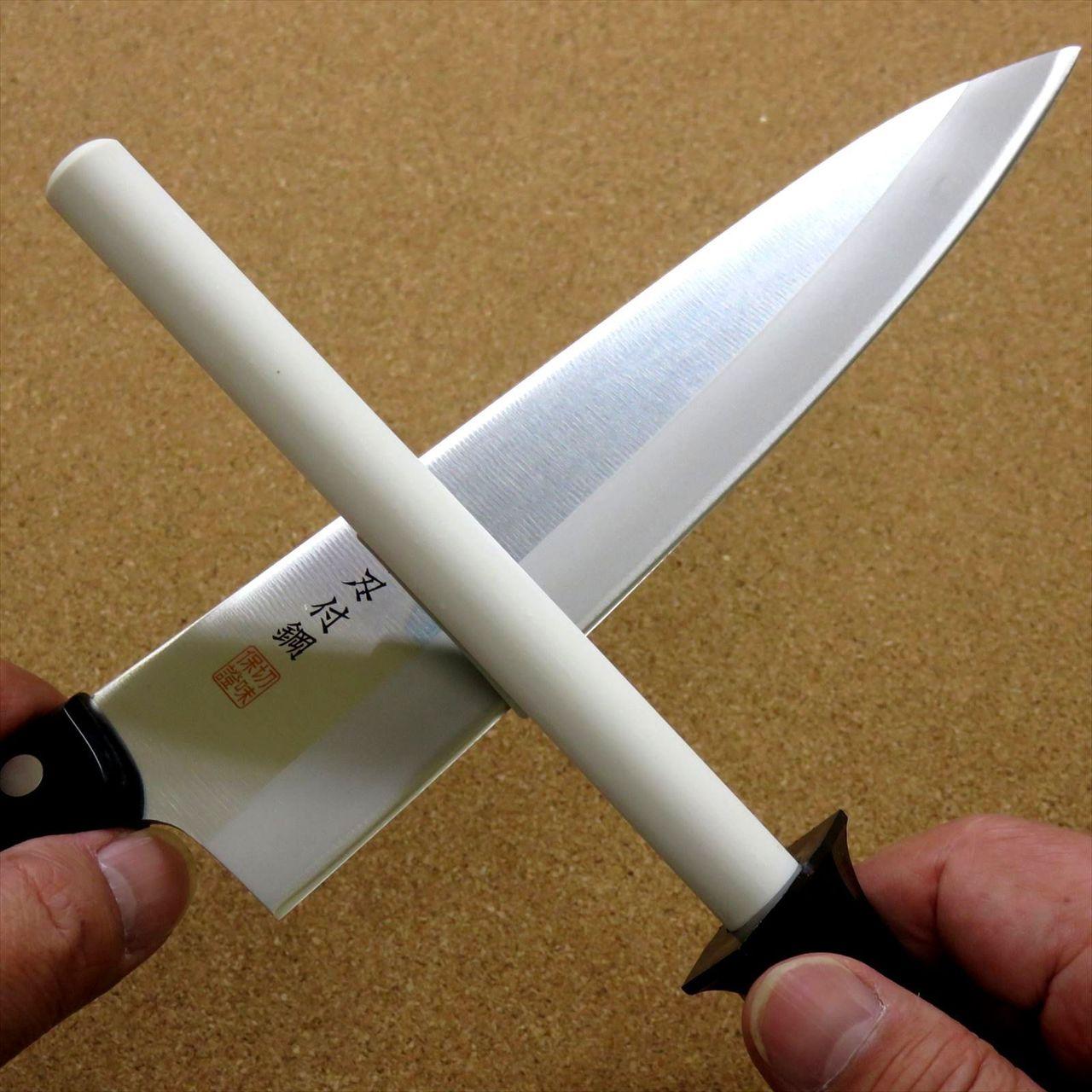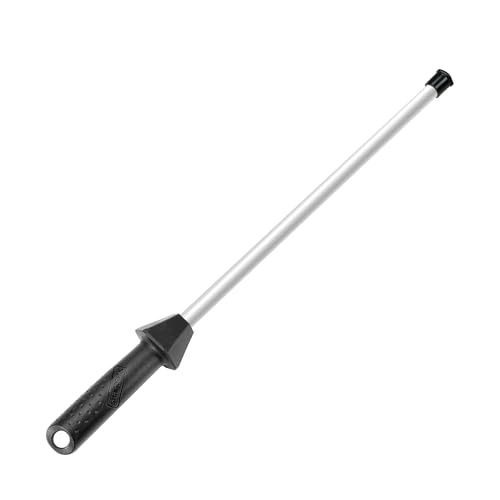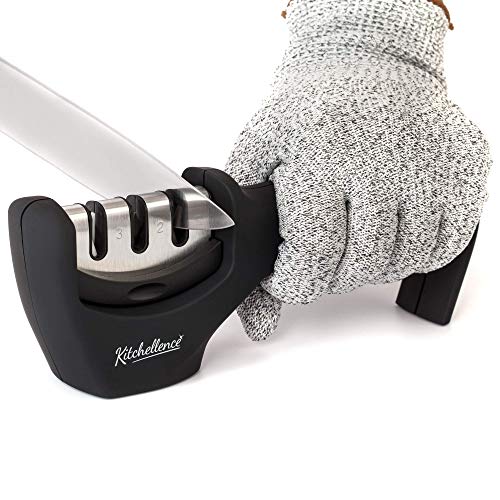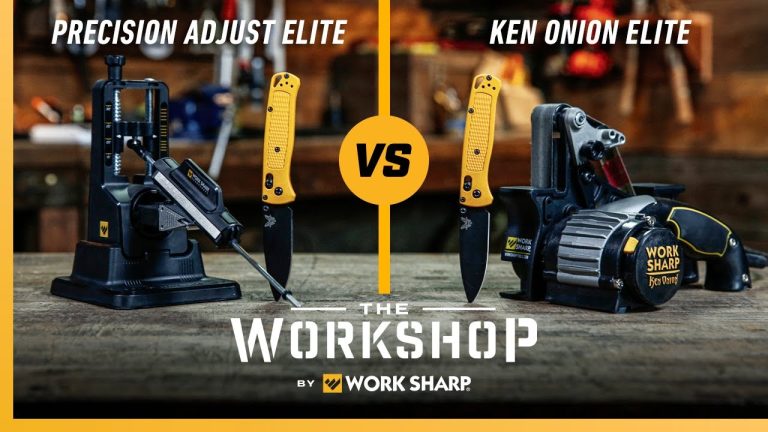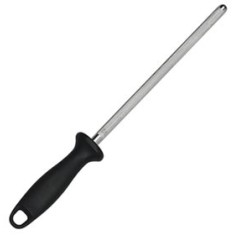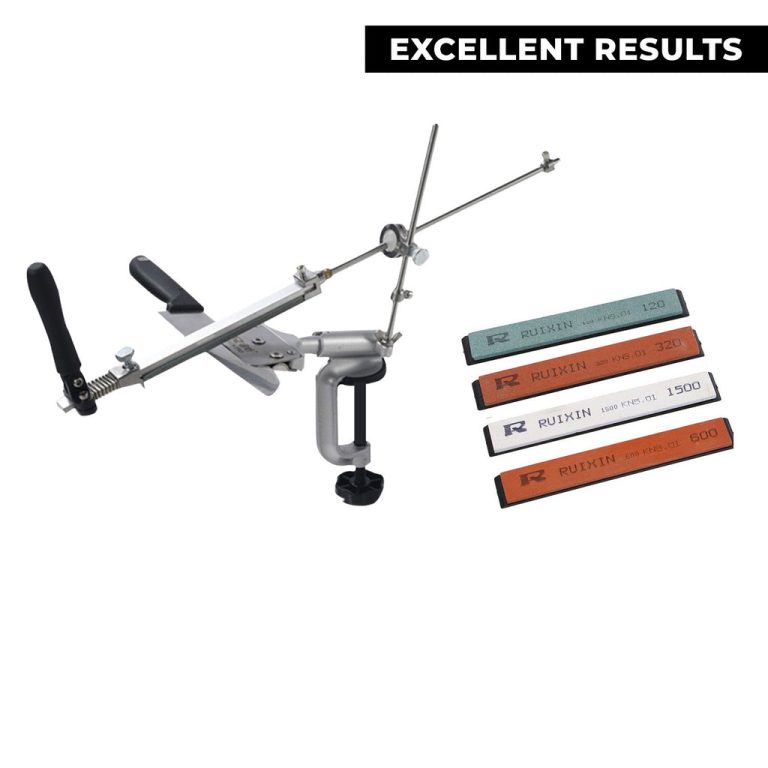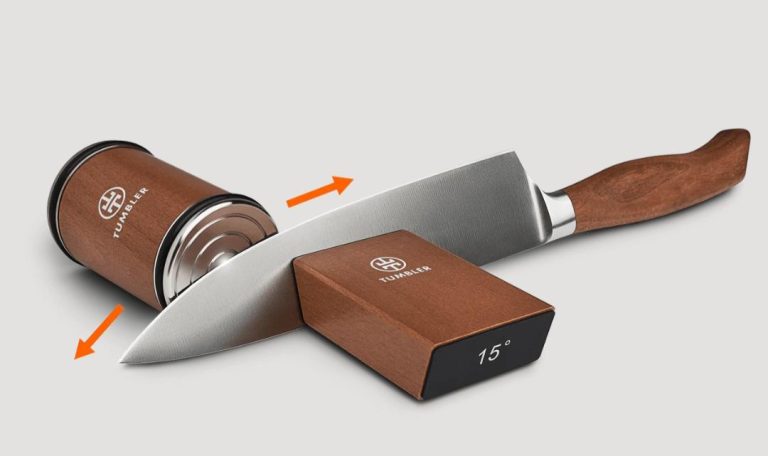Chef Knife Sharpening Stone Vs Ceramic: Ultimate Comparison Guide
Choosing the right tool to sharpen your chef knife is essential. Two popular options are sharpening stones and ceramic sharpeners.
Understanding the differences between these tools can help you make an informed decision. Sharpening stones have been used for centuries. They provide precise control and can sharpen various blades. Ceramic sharpeners are relatively new. They offer convenience and speed. This comparison will help you decide which tool suits your needs best.
We will explore the pros and cons of each option. By the end, you will know which sharpening method is right for you. Let’s dive into the details of sharpening stones and ceramic sharpeners.

Credit: jp-knives.com
Introduction To Knife Sharpening
Knife sharpening is an essential skill for any chef or cooking enthusiast. A sharp knife makes cooking easier and safer. Two popular methods for sharpening knives are using a sharpening stone or a ceramic sharpener. Each method has its own benefits and drawbacks. Understanding these can help you choose the best tool for your needs.
Importance Of Sharp Knives
Sharp knives are crucial in the kitchen. They cut more efficiently and require less effort. This reduces the risk of accidents, as a dull knife can slip and cause injuries. Sharp knives also help in maintaining the texture and appearance of food, providing cleaner cuts.
Common Sharpening Methods
There are several ways to sharpen a knife. The most common methods include:
- Sharpening Stones: These are traditional tools used for centuries. They come in different grits, from coarse to fine. They can sharpen knives to a very fine edge.
- Ceramic Sharpeners: These are modern tools that use ceramic rods. They are easy to use and maintain. Ceramic sharpeners are good for quick touch-ups and keeping the edge sharp.
- Electric Sharpeners: These tools use motorized wheels. They are quick and convenient. Electric sharpeners are good for those who want a fast solution.
Each method has its own pros and cons. Choosing the right one depends on your needs and preferences.
Table Of Comparison
| Feature | Sharpening Stone | Ceramic Sharpener |
|---|---|---|
| Ease of Use | Requires Skill | Easy |
| Maintenance | High | Low |
| Precision | High | Moderate |
| Cost | Varies | Affordable |
Both sharpening stones and ceramic sharpeners have their place in the kitchen. Understanding their differences can help you keep your knives in top condition.

Credit: www.amazon.com
What Is A Sharpening Stone?
A sharpening stone helps keep a chef’s knife sharp and effective. Chef knife sharpening stones offer precise control. Ceramic options provide convenience and durability.
A sharpening stone is a tool used to sharpen the edges of steel tools. This includes knives, scissors, and other cutting instruments. Sharpening stones are made from various materials and come in different shapes and sizes.Types Of Sharpening Stones
Sharpening stones are classified based on their material. The common types include oil stones, water stones, and diamond stones. Oil stones use oil as a lubricant during sharpening. Water stones use water, making them easier to clean. Diamond stones have a diamond grit surface for faster sharpening.How Sharpening Stones Work
Sharpening stones work by grinding away the metal from the blade. This process creates a new, sharp edge. The stone’s surface is abrasive, allowing it to wear down the blade’s metal. This action straightens and refines the edge. Different grit levels offer varying degrees of sharpness. Coarse grits remove more metal, while finer grits polish the edge. “`What Is A Ceramic Sharpener?
A ceramic sharpener is a tool used to refine the edge of a knife. It is made from high-quality ceramic materials. Ceramic sharpeners are known for their durability and efficiency. They help maintain a sharp edge for a long time.
These sharpeners come in various forms. They suit different types of knives and user preferences. They are popular among both home cooks and professional chefs. Let’s explore the types and workings of ceramic sharpeners in detail.
Types Of Ceramic Sharpeners
Ceramic sharpeners come in several types. Each type has its own advantages and uses. Here are the main types:
- Ceramic Rods: These are cylindrical rods. They are easy to use and store.
- Ceramic Wheels: These are found in manual or electric sharpeners. They offer consistent results.
- Ceramic Stones: These are flat stones. They provide a large surface area for sharpening.
Choose the type that best fits your needs and comfort level.
How Ceramic Sharpeners Work
Ceramic sharpeners work by removing tiny bits of metal from the knife edge. This process creates a finer, sharper edge. Here’s a simple breakdown:
- Hold the knife at the correct angle.
- Slide the knife across the ceramic surface.
- Repeat until the knife is sharp.
The ceramic material is harder than the knife steel. This allows it to effectively sharpen the blade. Regular use keeps your knives in top condition.
Here’s a quick comparison to help you understand better:
| Feature | Ceramic Rods | Ceramic Wheels | Ceramic Stones |
|---|---|---|---|
| Ease of Use | High | Medium | Low |
| Consistency | Medium | High | High |
| Surface Area | Low | Medium | High |
Understanding these types and how they work helps you choose the right ceramic sharpener. This ensures your knives stay sharp and ready for use.
Performance Comparison
Choosing the right tool for sharpening your chef knife is vital. Chef knife sharpening stones and ceramic sharpeners both offer unique benefits. This section compares their performance, focusing on sharpness results and durability.
Sharpness Results
Sharpening stones are known for providing precise and razor-sharp edges. They are versatile and can work on various knife types. Users can adjust the angle and pressure for a custom edge.
Ceramic sharpeners offer quick results and are easy to use. They deliver a sharp edge but may not match the precision of a sharpening stone. They are great for quick touch-ups.
| Sharpening Tool | Sharpness Level | Ease of Use |
|---|---|---|
| Sharpening Stone | High | Moderate |
| Ceramic Sharpener | Moderate | High |
Durability And Longevity
Sharpening stones are durable and can last for years if maintained properly. They require regular flattening to avoid uneven surfaces.
Ceramic sharpeners are durable but can wear out over time. They are less prone to damage but might need replacement after extensive use.
- Sharpening stones need regular maintenance.
- Ceramic sharpeners may require periodic replacement.
Ease Of Use
When choosing between a chef knife sharpening stone and a ceramic sharpener, ease of use is a crucial factor. Many users want a tool that is simple and effective. Let’s explore the user-friendly aspects and learning curve of both options.
User-friendly Aspects
Sharpening stones offer a traditional approach. They require water or oil for lubrication. Some users find this process relaxing. Ceramic sharpeners, on the other hand, are more straightforward. They often come in a pull-through design. This makes them quick and easy to use.
Sharpening stones need a flat surface. This can be a challenge in small kitchens. Ceramic sharpeners can be used almost anywhere. They are also more portable. This makes them convenient for frequent travelers or those with limited space.
Learning Curve
Using a sharpening stone requires some practice. You need to maintain the correct angle. Consistency is key for effective sharpening. Beginners may find this difficult at first. There are many tutorials available to help.
Ceramic sharpeners have a much shorter learning curve. Most models are designed for ease of use. Simply pull the knife through the slots. This makes them ideal for those who want quick results without much effort. Even a beginner can achieve a sharp edge with minimal practice.
Maintenance And Care
Maintaining and caring for your chef knife sharpening tools is essential. Proper care ensures long-lasting performance and safety. Let’s explore the best practices for cleaning and storing sharpening stones and ceramic sharpeners.
Cleaning And Storing Sharpening Stones
Sharpening stones need regular cleaning to stay effective. After each use, rinse the stone with water to remove metal particles. Use a brush to scrub gently if needed.
- Rinse with water: Flush out metal debris.
- Use a brush: Lightly scrub to remove stubborn particles.
- Dry thoroughly: Prevent mold and mildew by air drying.
For oil stones, apply a few drops of mineral oil before storage. This prevents the stone from drying out.
Store your sharpening stones in a dry, cool place. Use a protective case if available to avoid damage.
Cleaning And Storing Ceramic Sharpeners
Ceramic sharpeners also need proper cleaning. After each use, wipe the ceramic rod with a damp cloth. This removes any metal shavings.
- Wipe with a damp cloth: Clean off metal residue.
- Use mild soap: Wash with soap if heavily soiled.
- Rinse and dry: Ensure complete drying to avoid rust.
Storing ceramic sharpeners correctly is vital. Place them in a protective sleeve or case. This prevents chips and cracks. Keep them in a dry, cool place, away from heavy objects.
| Care Task | Sharpening Stones | Ceramic Sharpeners |
|---|---|---|
| Cleaning | Rinse, brush, dry | Wipe, soap, rinse |
| Storage | Dry, cool place, protective case | Dry, cool place, protective sleeve |
Proper maintenance of your sharpening tools ensures they last longer. It also provides a better sharpening experience. Follow these steps to keep your tools in top condition.
Cost And Value
Choosing the right sharpening tool is crucial for maintaining a chef’s knife. The cost and value can vary significantly between sharpening stones and ceramic rods. Understanding these differences helps in making an informed decision.
Initial Investment
Sharpening stones usually require a higher initial investment. Quality stones can range from $30 to $200. The price depends on the grit and material. Ceramic rods are generally less expensive. They often range from $10 to $50. This makes them more accessible for beginners or those on a budget.
Long-term Value
Sharpening stones offer more long-term value. They last for years with proper care. They can handle various sharpening tasks. This versatility can save money over time. Ceramic rods may wear out faster. They are best for maintaining an already sharp edge. Frequent replacement might be necessary, which can add to long-term costs.
In conclusion, while the initial investment for sharpening stones is higher, their long-term value makes them a better choice for serious chefs. Ceramic rods are cost-effective for light maintenance but may incur more replacement costs in the long run.
Choosing The Right Tool
Finding the right tool for sharpening your chef knife can be challenging. Many options exist, but two popular choices are sharpening stones and ceramic sharpeners. Each has its own advantages and best use cases. Understanding these can help you make the right choice.
Factors To Consider
When choosing between a sharpening stone and a ceramic sharpener, consider the blade material. Sharpening stones work well with most blade types, offering a precise edge. Ceramic sharpeners are ideal for maintaining already sharp blades.
Think about your skill level. Sharpening stones require more technique and patience. Ceramic sharpeners are user-friendly and quicker to use. Consider your time availability. Sharpening stones take longer but provide a finer edge. Ceramic sharpeners are faster but may not achieve the same precision.
Best Use Cases For Each
Sharpening stones are best for professional chefs and enthusiasts. They offer control and a fine edge for high-quality knives. Ceramic sharpeners are great for home cooks. They keep knives sharp with minimal effort.
For older or damaged knives, sharpening stones are a better choice. They can restore the blade’s edge effectively. Ceramic sharpeners are suited for regular maintenance of newer knives. They help retain the sharpness without much hassle.

Credit: www.amazon.com
Frequently Asked Questions
What Is A Sharpening Stone?
A sharpening stone, also known as a whetstone, is used to sharpen and hone the edges of knives. It requires water or oil for lubrication.
How Does A Ceramic Knife Sharpener Work?
A ceramic knife sharpener uses abrasive ceramic materials to hone and sharpen the blade. It’s simple, efficient, and ideal for quick touch-ups.
Which Is Better: Sharpening Stone Or Ceramic?
Choosing between sharpening stone and ceramic depends on your needs. Sharpening stones offer precise control, while ceramic sharpeners are quick and easy.
Can Ceramic Sharpeners Damage Knives?
Ceramic sharpeners are generally safe but can cause minor abrasions if used improperly. It’s essential to follow the manufacturer’s instructions.
Conclusion
Choosing between a sharpening stone and a ceramic knife sharpener depends on your needs. Sharpening stones offer more control and precision. Ceramic sharpeners are easier and quicker. Both have their advantages. Consider your skill level and time available. For detailed sharpening, stones are great.
For quick touch-ups, ceramic works well. Ultimately, the best tool is one you feel comfortable using. Maintain your knives regularly for best performance. Happy cooking!
